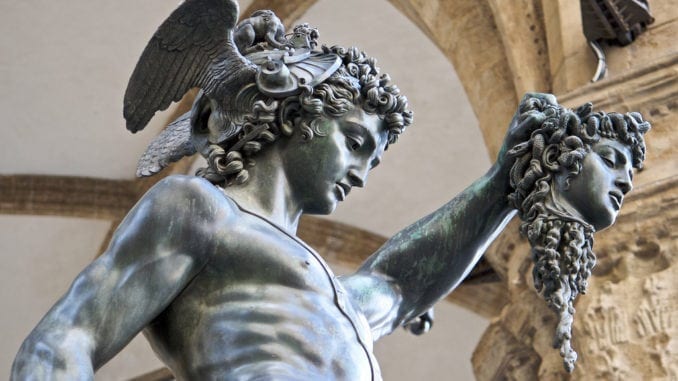

Other theories have explored the roots of the myths in linguistic, psychoanalytical or sexual terms. According to such theories, the Gorgon or Gorgons may have been one or more local deities. Theories have attempted to trace the origins of the Gorgon myths to Greek conquests and colonization, and the assimilation or destruction of indigenous religions. However, Aeschylus locates them to the east of Greece, on the "Gorgonean plains of Cisthene", and another source relates that they lived on an island called Sarpedon, perhaps one of two places said to have had this name in Thrace and Anatolia (Asia Minor). Herodotus, Pausanias and Ovid wrote that they were from Libya, the Greek name for northwest Africa. Hesiod ( Theogony, lines 270-303) described them living near the Hesperides, far to the west of Greece, across the Mediterranean in north Africa. The original home of the Gorgons is uncertain. (See Pergamon gallery 2, page 23 see also part of another frieze showing Athena fighting the Giants on Pergamon gallery 2, page 14.) The Gigantomachy is the subject of the frieze around the outside of the Pergamon Great Altar of Zeus. In the play Ion by Euripides, Gorgon was a monster produced by the Earth goddess Gaia to assist her sons, the Giants, in their battle against the gods (the Gigantomachy), during which he/she/it was killed by Athena.

Hyginus, Fabulae, sections 1-49, Excerpts from the Genealogiae of Hyginus, commonly called the Fabulae Preface. "From Gorgon and Ceto, Sthenno, Eurylae, Medusa" "From Typhon and Echidna: Gorgon, Cerberus, the dragon which guarded the Golden Fleece at Colchis, Scylla who was woman above but dog-forms below Chimaera, Sphinx who was in Boeotia, Hydra serpent which had nine heads which Hercules killed, and the dragon of the Hesperides." Īccording to the Roman mythographer Hyginus (see Medusa part 2), the sisters were the daughters of Keto and Gorgon, who was one of the many monstrous children of the Titans Typhon and Echidna: It was also referred to in the Library of Pseudo Apollodorus. Only fragments of the account survive in an ancient scholion (commentary) on the Argonautica by Apollonius Rhodius. Hesiod tells us that there were three Gorgon sisters, daughters of the chthonic sea deities Phorkys (Φόρκυς) and Keto (Κητώ): Stheno (Σθεννώ, mighty or forceful), Euryale (Εὐρυάλη, far-springer or far-roaming) and Medusa (the queen, or guardian, protectress), who was mortal.Īnother, perhaps more extensive account of the myth of Perseus and the Gorgons was written by the poet Pherecydes, around the first half of the 5th century BC, in the second book of his Genealogies. Hesiod ( Theogony, lines 270-303 ) was the first to record what came to be considered the essential myth concerning the Gorgons, including their birth, Medusa having sex with Poseidon and her death at the hands of the Greek hero Perseus (Περσεύς).

Homer only mentions the terrifying Gorgon's head the Gorgoneion (see below). The earliest known written accounts were by Homer and Hesiod, probably some time between the 8th - 7th centuries BC. Several versions of myths concerning the Gorgons were related by ancient Greek authors. Medusa (Μέδουσα, Medousa, guardian, protectress), also known as the Gorgon (Γοργώ, γοργών, γοργόνων, the Grim One, grim, fierce, terrible), was one of the three monstrous Gorgon sisters (Γόργονες, the Gorgons). See Medusa part 3.Īnd other Roman period funerary monuments The Medusa section has been divided into 8 pages: My Favourite Planet > English > People > Medusa part 1Īncient Greek mythology, religion and art Gorgon Medusa part 1 - My Favourite Planet People


 0 kommentar(er)
0 kommentar(er)
